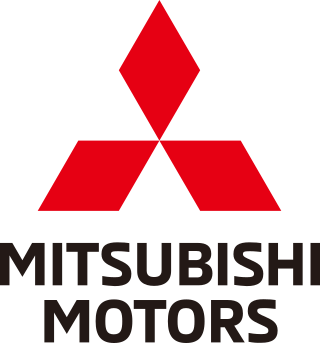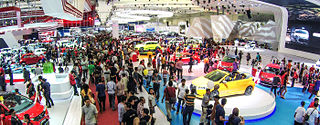
Nissan Motor Co. Ltd., often shortened to Nissan, is a Japanese multinational automobile manufacturer headquartered in Nishi-ku, Yokohama, Japan. The company sells its vehicles under the Nissan and Infiniti brands, and formerly the Datsun brand, with in-house performance tuning products labelled Nismo. The company traces back to the beginnings of the 20th century, with the Nissan zaibatsu, now called Nissan Group.

Mitsubishi Motors Corporation is a Japanese multinational automobile manufacturer headquartered in Minato, Tokyo, Japan. In 2011, Mitsubishi Motors was the sixth-largest Japanese automaker and the 19th-largest worldwide by production. Since October 2016, Mitsubishi has been one-third (34%) owned by Nissan, and included in the Renault–Nissan–Mitsubishi Alliance.

Daihatsu Motor Co., Ltd., commonly known as Daihatsu, is a Japanese automobile manufacturer and one of the oldest surviving Japanese internal combustion engine manufacturers. The company's headquarters are located in Ikeda, Osaka Prefecture.

Isuzu Motors Ltd., commonly known as Isuzu, is a Japanese multinational automobile manufacturer headquartered in Nishi-ku, Yokohama, Japan. Its principal activity is the production, marketing and sale of Isuzu commercial vehicles and diesel engines.
Captive import is a marketing term and a strategy for a vehicle that is foreign-built and sold under the name of an importer or by a domestic automaker through its own dealer distribution system.

Since 2009, the United States is home to the second largest passenger vehicle market of any country in the world, second to China. Overall, there were an estimated 263.6 million registered vehicles in the United States in 2015, most of which were passenger vehicles. This number, along with the average age of vehicles, has increased steadily since 1960. The United States is also home to three large vehicle manufacturers: General Motors, Ford Motor Company, and Chrysler, which have historically been referred to as the "Big Three".

The automotive industry in China has been the largest in the world measured by automobile unit production since 2008. Since 2009, annual production of automobiles in China accounted for more than 32% of worldwide vehicle production, exceeding both that of the European Union and that of the United States and Japan combined.
A world car is a car platform designed to suit the needs of global automotive markets with minimal changes in each market where it is sold. The goal of a world car program is to save costs and increase quality by standardizing parts and design for a single vehicle in a certain class, in hopes of using the cost savings to deliver a superior product that satisfies expectations for quality, appeal and performance of automobile buyers worldwide. Examples include the Ford Mondeo and Focus, modern no-frills cars such as the Fiat Palio, Dacia Logan and VW Fox along with luxury cars such as the BMW 3 Series and Lexus LS.

A substantial car industry was created in Australia in the 20th century through the opening of Australian plants by international manufacturers. The first major carmaker was Ford Australia and the first Australian-designed mass production car was manufactured by Holden in 1948. Australian manufacture of cars rose to a maximum of almost half a million in the 1970s and still exceeded 400,000 in 2004. Australia was best known for the design and production of 'large' sized passenger vehicles. By 2009 total production had fallen to around 175,000 and the Australian market was dominated by cars imported from Asia and Europe.
This article provides an overview of the automotive industry in countries around the world.

Ford Motor Company is an American multinational automobile manufacturer headquartered in Dearborn, Michigan, United States. It was founded by Henry Ford and incorporated on June 16, 1903. The company sells automobiles and commercial vehicles under the Ford brand, and luxury cars under its Lincoln brand. Ford also owns Brazilian SUV manufacturer Troller, an 8% stake in Aston Martin of the United Kingdom and a 32% stake in China's Jiangling Motors. It also has joint ventures in China, Taiwan, Thailand, and Turkey. The company is listed on the New York Stock Exchange and is controlled by the Ford family; they have minority ownership but the majority of the voting power.

The automotive industry in Japan is one of the most prominent and largest industries in the world. Japan has been in the top three of the countries with the most cars manufactured since the 1960s, surpassing Germany. The automotive industry in Japan rapidly increased from the 1970s to the 1990s and in the 1980s and 1990s, overtook the U.S. as the production leader with up to 13 million cars per year manufactured and significant exports. After massive ramp-up by China in the 2000s and fluctuating U.S. output, Japan is currently the third largest automotive producer in the world with an annual production of 9.9 million automobiles in 2012. Japanese investments helped grow the auto industry in many countries throughout the last few decades.

The automotive industry in Indonesia plays an important role to the economic growth of the nation, contributing 10.16 percent of the GDP. Indonesia automotive product exports is currently higher in value than their imports. In 2017, Indonesia is the 17th largest passenger vehicle producer in the world and the 5th largest passenger vehicle producer in Asia, producing 0.98 million vehicles.

As of 2019, the automotive industry in Thailand is the largest in Southeast Asia and the 10th largest in the world. The Thai industry has an annual output of more than two million vehicles, more than countries such as Belgium, Canada, the United Kingdom, Italy, Czech Republic and Turkey.

The automotive industry in Vietnam is a fast-growing sector mainly reliant on domestic sales. All currently produced models are designed abroad by foreign brands, and many rely on knock-down kit production. Due to a high import taxes on automobiles, the Vietnamese government protects domestic manufacturing. Although Vietnam is a member of the ASEAN Free Trade Area, automobile imports fall under an exception. Since January 1, 2018, the 30% import tax has been discontinued as part of ASEAN agreements. Currently, the Vietnamese motor industry is not deemed competitive enough to make exports feasible. As of April 2018, 85% of car sales in Vietnam were produced domestically from CKD kits.

General Motors Japan, Ltd. is a Japanese company that specializes in automobile imports and previously automobile production. It is a subsidiary of the American company General Motors.
PT Astra Daihatsu Motor is an automobile manufacturing company based in Jakarta, Indonesia. It is a joint venture company between Daihatsu, Astra International and Toyota Tsusho. It is the largest car manufacturer in Indonesia by production output and installed capacity, and has been second best-selling car brand behind Toyota. ADM also supplied most Toyota-branded models sold in Indonesia, which includes compact cars such as Avanza, Rush, Agya and Calya.

General Motors (Thailand) Limited (GMT) was a holding company of sales and manufacturing subsidiaries of General Motors (GM) in Thailand. The company was registered in 1993 as a sales company and opened its manufacturing plant in 2000. At its height, GM Thailand exported vehicles to most regions in the world, including South America, Central America, Europe, Africa, the Middle East, Southeast Asia, Australia and Japan. In February 2020, GM announced that it would withdraw from the Thai market and the Rayong plant would be acquired by Great Wall Motors by the end of 2020. The company continued to support existing Chevrolet owners for ongoing aftersales, warranty and service.

The automotive industry in the Philippines is the 9th largest in the Asia-Pacific region, with approximately 273.4 thousand vehicles sold in 2019. Most of the vehicles sold and built in the Philippines are from foreign brands. For the most part, the Philippines is dominated by Japanese automobile manufacturers like most of its ASEAN neighbors. The automobile production in the country is covered under the Philippine Motor Vehicle Development Program implemented by the Board of Investments. In addition, there are also a small number of independent firms who assemble and fabricate jeepneys and other similar vehicles, using surplus engines and drivetrain parts mostly from Japan.















